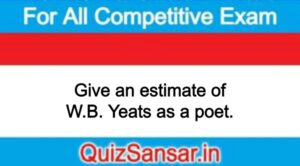
Give an estimate of W.B. Yeats as a poet.
Give an estimate of W.B. Yeats as a poet.
Ans.
Introduction
W.B. Yeats began his poetic career in 1880. His best poetry was composed between his age of fifty and seventy five. He developed his sense of disintegration of the mankind which he found around him. He had a great impact on literature and his technique. He filled his technique with symbolism, myths and mythological references. he shared his own problem with the generation of his time. He controlled himself in better way than his contemporaries to become too much deliberate in solving this problem. He wanted a solution for the sake of religious faith to new generation. In search of his new tradition, he went to romantic literature, then to mysticism of one kind to another, to folklore, symbolism and spiritualism. he wanted to give a shape to his problem of belief in God and religion.
His Mysticism
Most of the Yeats poems of later years are complex and mystical. He was not interested in saying or elevating anything in its original shape. He was mystical in the sense that he covered his all objects with a mask. In his search for a compensating tradition, the poet went to romantic literature, and then to symbolism. He was in search of a system to solve the problem of disbelief in the religion. Order, system and ritual, were not, for the poet a problem to express in wants disbelief in the religion. Order, system and ritual, were not, for the poet a problem to express in words, rather he wanted a traditional system to achieve an adequate poetic expression. David Dainote was not in favour of to assume that Yeats was a mystic but Yeats himself declared himself to be a poet of “mystical order.”
His Symbolism and Imagery
Yeats was a symbolist throughout his poetic career. He wrote about man’s pride, vulgarity, anxiety of future and refusal to assume despair. He is unique for the sources of his symbolism like myth, magic and history. He narrates about the belongings of the world. he replaced his own friends into articles and placed them in the hands of old heroic elders. His symbols are not inactive rather they change their forms as the lion in the British Museum seems ferocious but soon it departs to desert and slouches towards Bethlehem. His symbols are woven and serve to his purpose as instruments in his hands to the integration of the poem. His dominant symbols are trees, birds, tower, sea, house, rose or mask. Desert, havering birds, stony sleep and rocking cradle depict the situation of the mankind. Further, sun, moon, silver, gold, gyre, wheel and arrow like objects are his well-known symbols. He takes instances from different religions to explain his purpose.
Year’s Myths
W.B. Yeats is not an emotional poet of his age. He takes his problems with some instance forwarding and shaping into some myth. We find an image of the scene and his symbols in our minds during the study of his poems. He is a great story-teller. These stories are not of human beings, towns or of cities. He tells these stories from the Irish store told by the peasants about naturalness. In his poems we find his local flavour of atmosphere and tendency. His phrases are unknown to the English. Poets. His style bears the themes of ballads poetry, he depicts a land of his dreams. He was interested in Magic and supernatural objects which we find frequently in his poems. He glorifies the past history and elevates the present subject of poetry adding new myths and symbols.
His Greatness As a Poet
Yeats attained new symbols, myths and phrases for his poetry. He left his contemporary meter behind. His tones and metric verifications are new. His themes are modern in the sense that he keeps modern problems in his view and suggests a permanent solution to it avoiding the romantic despair. He has command over the formation of stanzas and couplets. He bears certain demerits of unknown images, myths and symbols. He connects the aesthetic pleasure with scientific pleasure in an old way. His hyperbolic phrases and resounding words create monotony. After all he is regarded a major poet for the qualities of his poetry.
-
Write the critical appreciation of the poem No. 12 entitled Far Below Flowed.
-
Write the critical appreciation of the poem No. 11 entitled Leave this Chanting.






